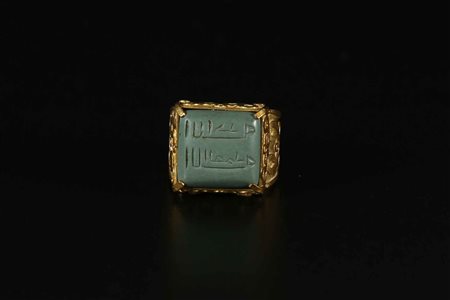 Capitolium Art - Via Carlo Cattaneo 55, 25121 Brescia
Capitolium Art - Via Carlo Cattaneo 55, 25121 Brescia
ASTA 193 - FINE CHINESE, ASIAN & ISLAMIC WORKS OF ART 3A SESSIONE
Friday 11 December 2015 hours 15:30 (UTC +01:00)
Arte Islamica Anello Fatimide in oro e turchese con iscrizioni Egitto, X -...
Arte Islamica Anello Fatimide in oro e turchese con iscrizioni
Egitto, X - XII secolo. . Cm 1,50 x 2,00 x 1,50. Anello in oro con fascia cesellata a rilievo con motivi vegetali stilizzati ripetuti e pietra rettangolare centrale incastonata e recante l'incisione: Allah Ahad, Allah Al Samad.
La gioielleria islamica è di difficile attribuzione in considerazione del fatto che si conoscano pochi esemplari con iscrizioni o databili con certezza o che la maggior parte siano stati dissotterrati illegalmente. Nonostante questo, uno scavo archeologico degli anni trenta del secolo scorso condotto a Ifriqiya, oggi in Tunisia, ha riportato alla luce della gioielleria e ottantadue monete, alcune recanti il nome di tre califfi Fatimidi, altre coniate nella provincia di Ifriquya nel periodo in cui gli Ziridi governavano in nome dei Fatimidi. Questo, insieme a considerazioni sulla similitudine di stili, iconografia e della conformità di metodi e tecniche utilizzate, ha portato gli studiosi ad estendere la datazione anche alla gioielleria che fu probabilmente sepolta a causa della persecuzione shiita che ebbe il suo culmine nel 1049 - 50 AD. (cfr. Marilyn Jenkins, Fatimid jewelry, its subtypes and influences, in Ars Orientalis, 1988, vol. 18 pp. 39 - 57).
La citata scoperta getta luce sulla gioielleria Fatimide ed aiuta ad ascrivere anche il presente anello a tale produzione.
L'oggetto è corredato di un certificato di autenticità stilato negli Stati Uniti e datato Ottobre 2009.
Arte Islamica A golden Fatimid ring with inscriptions
Egypt, 10th - 12th century. . Cm 1,50 x 2,00 x 1,50. This golden ring has a chiseled strip in relief with repeated plant motifs and a stone inlaind at the center. The stone has the inscription "Allah Ahad, Allah Al Samad". It's not easy to date an Islamic jewel, because in most cases it is not possible to ascribe them to a certain period and they have been unearthed illegally. Anyway, during an excavation made in 1930s at Ifriqiya (modern-day Tunisia), archaeologists found some jewels and eighty-two coins – some with the name of three Fatimid caliphs on them. They were coined in Ifriqiya province during the Zirids' reign. Judging by this fact and the similarity in styles, iconography and forging techniques, scholars now believe that it's possible to date even those jewels buried during Shiite's persecutions, which reached their most violent years in 1049/50 AD (see Marilyn Jenkins, Fatimid jewelry, its subtypes and influences, in Ars Orientalis, 1988, vol. 18 pp. 39 - 57).
The discovery made in Ifriqiya helps ascribe this golden ring to the same production, and the lot has its certificate of authenticity made in the United States in October, 2009.





